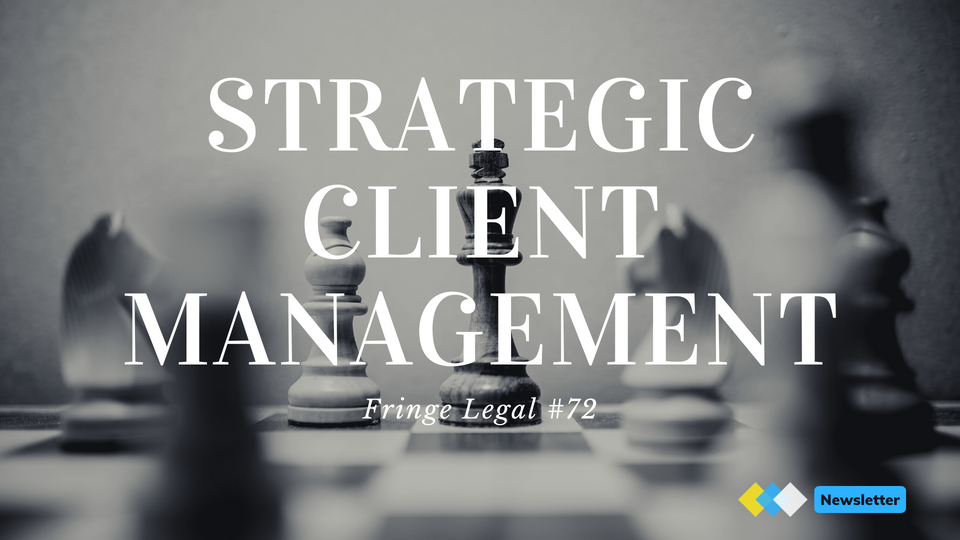Fringe Legal #72: strategic client management

Grab a cup of ☕ this is a long read.
Turn key clients ➡ major accounts using Strategic Client Management
57.1% of clients will change law firms for client service reasons [1]. This ranks higher than factors like legal expertise and cost.
This highlights a key issue: law firms are lagging behind other professional services when it comes to client management.
In the past, I shared that the legal sector has an NPS of -54. Increasing the NPS of your firm by 7% increases the revenue by 1% [2]. Strategic Client Management is a way to impact the revenue and stickiness of your customers.
What is Strategic Client Management?
Strategic Client Management is the nurturing of long-term profitable client relationships through more intentional efforts and collaboration. It puts the client's needs at the forefront of the relationship and helps law firms focus on meeting those needs.
Lawyers aren't always the best at collaboration. This can hurt their relationships with their clients. This behavior starts in law school. At the heart of law school is competition: every student is out for themselves, and class rank is of the utmost importance. Conversely, in business school, everything is done in teams, and teamwork is highly valued. This lack of collaboration among lawyers can have devastating effects later in their professional lives.
If you aren't managing your relationships strategically, you are losing clients because there is another firm out there that is.
Additionally, most lawyers are well-paid: the average salary of an Am Law 200 partner is about $1.6M [3]. This doesn't create much incentive to collaborate and make changes. However, this is slowly beginning to change.
Over the last few years, there's been a shift towards law firms running themselves in a much more business-centric way. Firms are being more intentional about how their client relationships are managed, nurtured, and expanded. Competition is higher now than it has ever been. If you aren't managing your relationships strategically, you are losing clients because there is another firm out there that is.
Creating stronger client relationships through collaboration
Client relationships are the lifeblood of any law firm.
When lawyers collaborate, they end up with better and "stickier" client relationships, which means less “nickel-and-diming,” or needing to rely on billing small insignificant services to increase revenues. With Strategic Client Management, people stop talking to you about fees and costs a lot more because they feel that you are actually serving their needs and perceive the value received to be much higher.
Working collaboratively also contributes to the resilience of the firm. According to research from Dr. Heidi Gardner [4], during the 2007 recession, the top 10 % of collaborators didn't take a hit. The next 20% had a small dip, but bounced back, while the remaining 69% never recovered fully. This shows how creating better client relationships through collaboration results in a more stable, resilient firm.
Collaboration doesn’t only create benefits for the firm. For an individual lawyer working with a client and selling discrete services, aggregate revenue will increase from 0 to about $200K. Within a collaborative relationship, aggregate revenue will increase from 0 to almost $1M for the same client. When the pie is bigger, everyone gets a bigger piece.
Many times, there's not as much glory in expanding a relationship as there is in snagging a new client, but it's almost always a more profitable business move.
Ultimately, as a lawyer, you must think of your clients as your asset. This starts by prioritizing your existing clients. Many times, there's not as much glory in expanding a relationship as there is in snagging a new client, but it's almost always a more profitable business move. Many lawyers don't understand that not every dollar of revenue is equal. You don't put your kids through school or buy your dog's food out of revenue. You buy it out of profits.
How to improve collaboration in your law firm
Improving collaboration between lawyers begins with a change in mindset. Most lawyers view collaboration in terms of cross-selling; the key is to instead shift to cross-servicing. In cross-selling, the goal is to get the client to purchase what the firm wants them to have. With cross-servicing, the needs of the client are at the forefront. The goal is to determine what services benefit the client the most and how to help them to meet their goals.
Lawyers need to know their clients almost as well, if not better than they know themselves. This allows you to understand what their needs really are and how you can best serve them. Clients hate being sold to, but if you come to them with a solution, they are more likely to listen. Solutions are valuable to your clients. Legal expertise and cost considerations are not.
Most lawyers view collaboration in terms of cross-selling; the key is to instead shift to cross-servicing.
It is almost impossible for an individual to offer a solution to all of the client's problems. We live in a time of specialized knowledge; therefore, a team can put together a solution more easily than an individual can. This is where collaboration yields the best results. It's having an intentional, purposeful, strategic discussion with the client based on your knowledge of what their issues are. This results in a true partnership between lawyer, law firm, and client.
The Client Feedback Loop in Strategic Client Management
At the foundation of the law firm/client partnership is a robust client feedback loop. Begin by drafting an annual client service plan that outlines key strategies and goals for the client. Then, break those strategies into tasks, which can have someone assigned to them and a timeline for when they should be completed. The relationship partner should track the progress on these tasks throughout the year to give the tasks metrics and accountability. The plan should also be easily adjustable so that changes can be made as needed.
To maximize collaboration, the client plan should be shared with the team of lawyers responsible for that client. Recognition for those who are completing their tasks and meeting their goals is also an important piece.
The final step is to share the plan with the client to get their feedback. Even if they don't like the specific plan, they will appreciate that you took the time to think about their needs. The goal is to gather feedback that will allow you to adjust the plan to make it the best fit for the client.
Getting into a change mindset
Major change involves many incremental changes and requires resources. There must be a commitment to change across the firm, including from the top. To facilitate this commitment, law firm leaders should dedicate meaningful resources to implementing change and not rely solely on individual partners.
Major change involves many incremental changes and requires resources
A small-scale pilot can often be less intimidating and will allow the users to see how everything will work. Once the pilot program is in place, use it to pick out the early adopters. Find those who pick up changes early and amplify their success. You can also use the competitive nature of lawyers to your advantage. If lawyers see others in the firm benefiting from a new program, they will also want to adopt it.
Tracking progress and measuring success
One of the potential pitfalls in implementing Strategic Client Management is that there can be a lag time before firms start to see better financial outcomes. Another is that many firms don’t allocate enough resources to fully implement Strategic Client Management. Firms must make the commitment to change, which starts with allocating the right amount of budget and personnel to achieve success.
A great way to track progress is to create individual action plans for each partner. This will help them understand what changes need to be made and give lawyers in your firm security in the knowledge that they will be supported through these changes.
Finally, you must have a way to determine if your program is having success. There are several indicators you can use to do so. Is the firm expanding the number of partners, practice areas, or offices that are meaningfully involved with clients? If so, this is a sign that there is more collaboration happening. Is the firm having more meaningful interactions with the client? This is a sign that there is a closer relationship being formed with the client, which will lead to the firm's better understanding of the client's needs.
Summary
Strategic Client Management allows firms to build closer relationships with their clients. By focusing on collaboration and helping clients solve the problems they're having, a better relationship is formed between the law firm, the lawyer, and the client. This leads to more profitable client relationships and a more stable, successful law firm that's equipped to deal with challenges that may lie ahead.
Wished you could listen to this instead? Then check out the conversation with Janet Stanton on this very topic 🤘.
🎧 New podcast episode
Kai Jacob discusses digital transformation and designing the future of law.
I teased this episode last week with some highlights - it's worth a listen. Being embedded with customers is relevant to the theme of today's issue.
🔗other highlights
- Too many decisions in law firms are made in isolation. Good tweet from Jack Shepherd, and I like Justin North’s take on it:

- 36 lessons for [professional] life
- Context switching comes at a high cost
- Pixar's 22 rules of storytelling and how they can improve your pitches
- Value transformation







Become a Fringe Legal member
Sign in or become a Fringe Legal member to read and leave comments.
Just enter your email below to get a log in link.